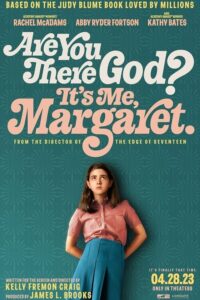 If you’ve never been an adolescent girl, particularly one coming of age in the late 1960s, then perhaps Judy Blume’s classic “Are You There God? It’s Me, Margaret” isn’t a book, or movie, that you’ll enjoy.
If you’ve never been an adolescent girl, particularly one coming of age in the late 1960s, then perhaps Judy Blume’s classic “Are You There God? It’s Me, Margaret” isn’t a book, or movie, that you’ll enjoy.
But because I was an adolescent girl in 1970 when the novel was first published, I loved it. I loved it even more when I re-read it before handing it over to my “tween-aged” daughters in the mid-1990s. And when I read “Margaret” for the third time earlier this month in preparation for seeing the long-anticipated movie, I loved it just as much as ever.
Our protagonist/narrator is Margaret Simon, who’s about to turn twelve and who’s been uprooted from the only home she’s ever known in New York City and moved to the suburbs of New Jersey. Her house is on Morningbird Lane, where all the houses and trees are seven years old and look a lot alike. Margaret isn’t happy about the move. She’ll miss the big city. She’ll miss her grandmother. She’ll miss her school and her friends.
As you might predict, Margaret is also eaten up with early-adolescent angst. She worries that her mother won’t buy her a bra until she really needs one. She worries about when she’ll have her first period. She worries that she’ll never have a boyfriend.
And on top of all that, Margaret is confounded about religion. Her father is Jewish. Her mother, raised Christian, was disowned by her conservative parents when she married outside her faith. Margaret has never met these grandparents. Margaret doesn’t go to Sunday School or church. She doesn’t go to temple. When her family moves to New Jersey, they join neither the Y nor the Jewish Community Center. Margaret’s parents tell her that when she grows up, she can decide for herself what religion she wants to be.
But here’s the thing. Margaret talks to God. A lot. She talks to him at night before she goes to sleep. She talks to him when she’s troubled or confused. She talks to him when she’s scared or worried. Margaret decides that her year-long sixth grade project, which her teacher insists must be “meaningful,” will be about religion. “I think it’s time for me to decide what to be,” she tells God. “I can’t go on being nothing forever, can I?”
Judged by today’s standards in controversial books, “Are You There God?” seems mild. But in its time, some critics considered it outrageous. Though the New York Times named it Outstanding Book of the Year in 1970, many schools—including the one Judy Blume’s own children attended—wouldn’t allow it in classrooms or the library. It remains on the American Library Association’s “One Hundred Most Frequently Challenged Books of All Times” list.
Why? Because in this novel and all of her other controversial works, Judy Blume tells the truth. She doesn’t dance around uncomfortable subjects. She doesn’t sugarcoat. That’s why her books have sold more than 90 million copies. It’s why they’ve been favorites of adolescent (and adult) readers for more than half a century. And it’s why some of the kids who read them, even today, do it in secret.
“Book bans aren’t protecting kids,” Judy Blume says. “They’re protecting adults from having to talk about things they don’t want to talk about.”
The 85-year-old, still-a-rock-star author is featured in a wonderful documentary entitled “Judy Blume Forever,” streaming now on Prime Video. I highly recommend it. And I highly recommend the movie “Are You There God? It’s Me, Margaret,” which—as this column goes to press—is playing at Cookeville’s Highland 12 theatre. It’s a pitch-perfect adaptation of the novel. As an added bonus, if you pay close attention, you’ll notice the author in a cameo role, walking a dog in Margaret’s neighborhood.
Go see it. You don’t have to be an adolescent girl to love this timeless story, I promise.
(May 20, 2023)